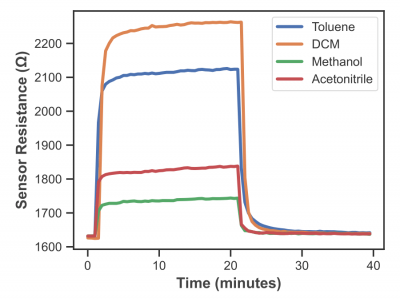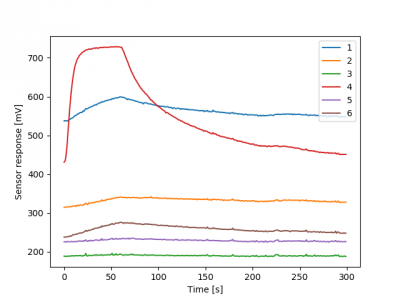electronic nose
This dataset contains 2,016 sensor responses collected from an array of conductive carbon-black polymer composite sensors, exposed to four target analytes—acetonitrile, dichloromethane (DCM), methanol, and toluene—at nine distinct concentration levels ranging from 0.5% to 20% P/P₀. Each sensor was exposed to the analytes for 20 minutes, followed by 20 minutes of nitrogen flushing to restore the baseline. The data consists of 80 time points (one every 30 seconds) per response, with each time point representing the sensor's resistance to a specific analyte concentration.
- Categories:
 113 Views
113 Views
The dataset has 99 rows, corresponding to 99 odor samples, their labels are shown in label.xlsx
The dataset has 450 columns, corresponding to the responses of 30 odor sensors under 15 heating voltages (2.6V-5.4V).
Taking the first row as an example, the first to 15th elements correspond to the response values of sensor No.1 at heating voltage range from 2.6 V to 5.4 V in 0.2 V increments; The 16th to 30th elements correspond to the response values of sensor No.2 at heating voltage range from 2.6 V to 5.4 V in 0.2 V increments; And so on.
- Categories:
 191 Views
191 ViewsHere, we used a self-developed general purpose E-nose platform to analyze the chemical selection in calibration and measure the drift between different chemicals. The platform employs 41 gas sensors, including 37 distinct types of gas sensors and 4 environmentaldetection sensors to create a stable, automatic gas acquisition system.
- Categories:
 41 Views
41 Views
E-nose can be used for food authentication and adulteration assessment. Recently, halal authentication has gained attention because of cases of pork adulteration in beef. In this study, The electronic nose was built using nine MQ series gas sensors from Zhengzhou Winsen Electronics Technology Co., Ltd for detection pork adulteration in beef. The list of gas sensors are MQ2, MQ4, MQ6, MQ9, MQ135, MQ136, MQ137, and MQ138. These gas sensors were assembled with an Arduino microcontroller.
- Categories:
 1298 Views
1298 Views
The development of electronic nose (e-nose) for a rapid, simple, and low-cost meat assessment system becomes the concern of researchers in recent years. Hence, we provide time-series datasets that were recorded from e-nose for beef quality monitoring experiment. This dataset is originated from 12 type of beef cuts including round (shank), top sirloin, tenderloin, flap meat (flank), striploin (shortloin), brisket, clod/chuck, skirt meat (plate), inside/outside, rib eye, shin, and fat.
- Categories:
 1729 Views
1729 ViewsThis dataset contains the resuts of an experiment in which an electronic nose implemented with six MOX sensors acquired samples of explosives in raw and combined states.
As for the collection of samples, a random experimentation was carried out in order to avoid that data generates any memory effect that could influence the results. Raw TNT and gunpowder data were taken in amounts of 0.1g to 2g. Soap and toothpaste were also used to be mixed with the explosives. In the end, we took samples of the explosive substances in raw and combined states.
- Categories:
 859 Views
859 Views
